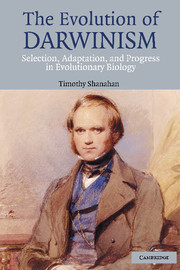1 - Darwin and Natural Selection
Published online by Cambridge University Press: 18 December 2009
Summary
Natural Selection, as we shall hereafter see, is a power incessantly ready for action, and is as immeasurably superior to man's feeble efforts, as the works of Nature are to those of Art.
(Darwin 1859, p. 61)Introduction
“After having been twice driven back by heavy south-western gales, Her Majesty's ship Beagle, a ten-gun brig, under the command of Captain Fitz Roy, R. N., sailed from Devonport on the 27th of December, 1831” (Darwin 1839, p. 1). So begins Darwin's travel journal, The Voyage of the Beagle, published in 1839. The purpose of the expedition was to survey the South American coast and to make chronometrical measurements. The twenty-two-year-old Darwin had signed on as (unofficial) ship naturalist and (official) “gentleman dining companion” for the captain. The expedition was planned as a two-year voyage. In fact, it would be nearly five years before the Beagle returned to England (29 October 1836). Its voyage proved to be the seminal experience in Darwin's life.
A Theory by Which to Work
The story of Darwin's discovery of “evolution by means of natural selection” has been told many times (e.g., Bowler; 1989; Young 1992). Although scholars continue to debate the relative importance of one or another element in this story, there is nonetheless widespread agreement on the basic factors that led Darwin to his theory.
- Type
- Chapter
- Information
- The Evolution of DarwinismSelection, Adaptation and Progress in Evolutionary Biology, pp. 11 - 36Publisher: Cambridge University PressPrint publication year: 2004



